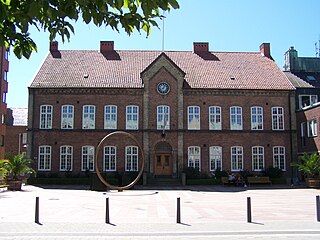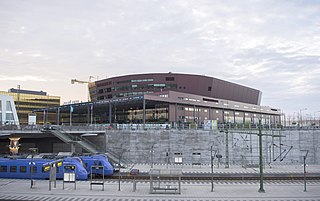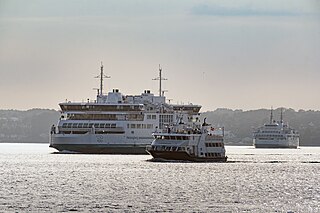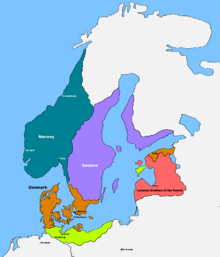
Malmö is the largest city in the Swedish county of Scania (Skåne). It is the third-largest city in Sweden, after Stockholm and Gothenburg, and the sixth-largest city in the Nordic region, with a municipal population of 357,377 in 2022. The Malmö Metropolitan Region is home to over 700,000 people, and the Öresund Region, which includes Malmö and Copenhagen, is home to four million people.

Transport in Sweden is available for all four main modes of transport—air, bus, ferry and rail—assisting residents and visitors without their own vehicle to travel around much of Sweden's 450,295 square kilometres (173,860 sq mi).

Øresund or Öresund, commonly known in English as the Sound, is a strait which forms the Danish–Swedish border, separating Zealand (Denmark) from Scania (Sweden). The strait has a length of 118 kilometres (73 mi); its width varies from 4 kilometres (2.5 mi) to 28 kilometres (17 mi). The narrowest point is between Helsingør in Denmark and Helsingborg in Sweden.

The Øresund or Öresund Bridge is a combined railway and motorway cable-stayed bridge across the Øresund strait between Denmark and Sweden. It is the second longest bridge in Europe with both roadway and railway combined in a single structure, running nearly 8 kilometres from the Swedish coast to the artificial island Peberholm in the middle of the strait. The crossing is completed by the 4-kilometre (2.5 mi) Drogden Tunnel from Peberholm to the Danish island of Amager.

Skåneland or Skånelandene (Danish) is a region on the southern Scandinavian peninsula. It includes the Swedish provinces of Blekinge, Halland, and Scania. The Danish island of Bornholm is traditionally also included. Skåneland has no official recognition or function and the term is not in common usage. Equivalent terms in English and Latin are "the Scanian Provinces" and "Terrae Scaniae" respectively. The term is mostly used in historical contexts and not in daily speech. In Danish, Skånelandene is used more often. The terms have no political implications as the region is not a political entity but a cultural region, without officially established administrative borders.

Ven, is a Swedish island in the Öresund strait laying between Skåne, Sweden and Zealand, Denmark. A part of Landskrona Municipality, Skåne County, the island has an area of 7.5 km2 (2.9 sq mi) and 371 inhabitants as of 2020. During the 1930s, the population was at its peak, with approximately 1,300 inhabitants. There are four villages on the island: Bäckviken, Tuna By, Norreborg and Kyrkbacken. The island is best known as the location of Danish Renaissance astronomer Tycho Brahe's observatories Uraniborg and Stjerneborg.
For hundreds of years up until the 18th century, the history of the province of Scania was marked by the struggle between the two Scandinavian kingdoms of Denmark and Sweden over the hegemony in the Baltic area.

The Øresund Region, also known as Greater Copenhagen for marketing purposes, is a metropolitan region encompassing the Capital Region of Denmark and Zealand, in eastern Denmark, and Scania, in southern Sweden. Centred around the Øresund strait and the two cities which lie on either side, Copenhagen in Denmark and Malmö in Sweden, the region is connected by the Øresund Bridge, which spans the strait at its southern end, and the HH Ferry route between Helsingør, Denmark, and Helsingborg, Sweden, at the narrowest point of the strait.

Helsingborg (,, Swedish:[hɛlsɪŋˈbɔrj], is a city and the seat of Helsingborg Municipality, Scania, Sweden. It is the second-largest city in Scania and ninth-largest in Sweden, with a population of 113,816. Helsingborg is the central urban area of northwestern Scania and Sweden's closest point to Denmark: the Danish city Helsingør is clearly visible about 4 km to the west on the other side of the Øresund.
The Skåne Market or Scania market was a major fish market for herring which took place annually in Scania during the Middle Ages. From around 1200, it became one of the most important events for trade around the Baltic Sea and made Scania into a major distribution center for West-European goods bound for eastern Scandinavia. The Scania Market continued to be an important trade center for 250 years and was a cornerstone of the Hanseatic League's wealth.
The Treaty of Copenhagen was signed on 27 May 1660, and marked the conclusion of the Second Northern War between the Swedish Empire and the alliance of Denmark-Norway and the Polish–Lithuanian Commonwealth. This treaty was a smaller follow-up treaty to that of the Treaty of Roskilde, which decisively delineated the mutually recognized boundaries of Denmark, Sweden, and Norway; boundaries which are almost exactly the same to this day.

The Nordic Passport Union allows citizens of the Nordic countries – Iceland, Denmark, Norway, Sweden, and Finland – to travel and reside in another Nordic country without any travel documentation or a residence permit. Since 25 March 2001, all five states are also in the Schengen Area.

Trelleborg is a town in Skåne County, Sweden, with 43,359 inhabitants as of December 31, 2015. It is the southernmost town in Sweden located some 10–15 kilometres (6.2–9.3 mi) west from the southernmost point of Sweden and the Scandinavian peninsula. It is one of the most important ferry towns in Scandinavia as well as around the Baltic Sea, and the main town of the Söderslätt agricultural areas.

The Øresund Line is a railway between Copenhagen in Denmark and Malmö in Sweden via the Øresund Bridge. It operates 24/7, and a journey between the two cities takes 35 to 40 minutes. On the Swedish side it is managed by the Swedish Transport Administration, on the Danish side by Banedanmark.

Scania, also known by its native name of Skåne, is the southernmost of the historical provinces of Sweden. Located in the south tip of the geographical region of Götaland, the province is roughly conterminous with Skåne County, created in 1997. Like the other historical provinces of Sweden, Scania still features in colloquial speech and in cultural references, and can therefore not be regarded as an archaic concept. Within Scania there are 33 municipalities that are autonomous within the Skåne Regional Council. Scania's largest city, Malmö, is the third-largest city in Sweden, as well as the fifth-largest in Scandinavia.

The relations between Denmark and Sweden span a long history of interaction. The inhabitants of each speak related North Germanic languages, which have a degree of mutual intelligibility. Both countries formed part of the Kalmar Union between 1397 and 1523, but there exists an inherited cultural competition between Sweden and Denmark. From 1448 to 1790 the two kingdoms went to war against each other at nearly every opportunity; in more than one case a new king tried to prove his worth by waging war on the other country for little or no political reason. Eleven Dano-Swedish wars took place between 1521 and 1814.

The Norway–Sweden border is a 1,630-kilometre (1,010 mi) long land national border, and the longest border for both Norway and Sweden. It is an external border for the EU (Sweden).

Hyllie Station is a railway station located in the Hyllie city district in the southwestern part of Malmö, Sweden. It is the final station on the Swedish side of the Öresund Line before trains pass the Öresund Bridge towards Denmark.

The Helsingør–Helsingborg ferry route is a shipping route connecting Helsingør (Elsinore), Denmark and Helsingborg, Sweden across the northern, and narrowest part of the Øresund. Due to the short distance, which is less than 3 nautical miles, is it one of the world's busiest international car ferry routes, with around 70 daily departures from each harbour. The oldest-known written mention of the route dates to the German traveller Adam of Bremen in the 11th century, but it has likely been in use much longer. Before 1658, the route was a domestic Danish route. For several centuries, the route has been run regularly by various Danish shipping lines. Its significance grew during the 1950s, but since the inauguration of the Øresund Bridge in 2000, at the southern end of the Øresund, it has lost some significance but remains as one of the world's most important ferry routes, particularly as a cheaper alternative to the bridge tolls. Since 1952, passports have not been required for citizens of the Nordic Passport Union countries. Since 2001, when both countries became members of the Schengen Area, passports are not needed for anyone.

The Kingdom of Denmark has existed with its current territory since 1920, although the last territorial dispute with Canada was only settled on June 14, 2022. The only land border of Denmark (proper) is that with Germany, with a length of 68 km (42 mi). Greenland, an autonomous country of the Danish Realm, also shares a border with Canada splitting Hans Island in half in which the border is 1.28 km long. The border along the territorial waters with Sweden runs along the Øresund for a length of about 115 km (71 mi).



















